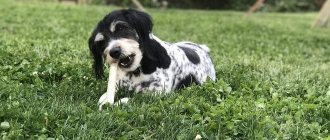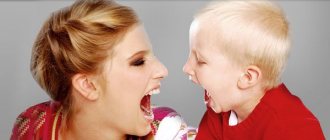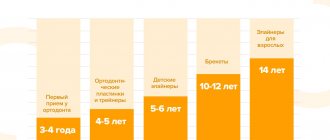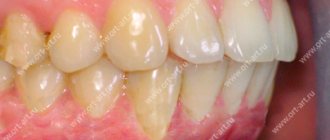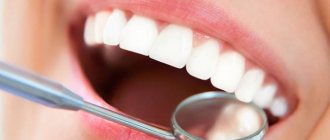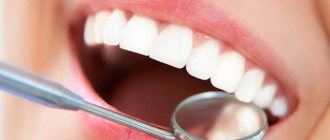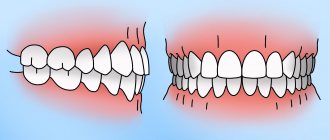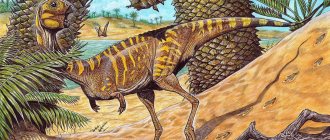Full health of a dog means the good condition of all its organs and systems, including teeth. Unfortunately, these friendly animals, which have served man faithfully for a long time, have not been spared many “human” diseases. One of them is an incorrect bite in a dog.
For breeding puppies or service breed dogs, this disease becomes a death sentence, excluding the right to serve or breed. In addition, this deficiency greatly affects the dog’s overall health.
Main types of bite
The jaws of dogs of different breeds may be positioned differently in relation to each other. The types of bites in dogs are as follows:
- scissor-shaped (normal);
- pincer-shaped (straight);
- undershot;
- snack (bulldog-shaped).
The bite of such pets depends primarily on the structure of their jaws. The latter can have different lengths and development.
Sometimes a dog's jaws can be distorted. Also, the position of the teeth has a great influence on the bite. Sometimes it happens that the dog’s jaws themselves are fine, but the teeth grow incorrectly.
Scissor bite
Representatives of the canid genus are known to belong to the group of predators. In the wild, such animals hunt other animals in order to feed themselves. Therefore, the structure of the jaws of canids, including dogs, is designed primarily to grab and hold prey. In this regard, the most physiological is the scissor bite.
This jaw structure is considered normal for most dog breeds. Animals with such a bite have much less wear and pain in their teeth. This structure is considered the norm, for example, for Caucasian and German shepherds, terriers, pinschers, and Dobermans. That is, the correct bite in dogs of most breeds is a scissor bite.
In this case, dogs’ jaws are developed harmoniously. The front surface of the lower incisors is tightly adjacent to the back surface of the upper ones. The canines of dogs with this type of bite meet in a “lock.” In this case, the lower incisors rest against the base of the upper ones. Photos of the bite in dogs of this variety can be seen above.
Pincer bite
This jaw position is considered unacceptable for most dog breeds. However, a pincer bite is still considered a not too serious defect. In this case, the dog’s lower and upper incisors are located on the same line and rest against each other. Because of this, they wear down very quickly. A direct bite in dogs usually does not have a negative effect on canines and molars.
Pincer-like closure of the incisors in dogs can be either congenital or acquired. Such a defect can develop, for example, due to the puppy playing tug too actively. Excessive loads of this kind, of course, are unlikely to have a negative impact on the jaw. However, a puppy's lower incisors may begin to move forward when pulled.
Underbite
This defect is considered more serious than a pincer bite. Underbite causes disqualification at shows of most dog breeds. The lower jaw in animals in this case is underdeveloped. Because of this, the dog has free space between the incisors. The lower canines are loosely adjacent to the edges of the upper jaw.
This type of defect can lead to the development of serious dental diseases in pets. The most affected dogs with this type of bite are the canines and molars. In this case, they are adjacent to each other too tightly. Also, dogs with this problem often develop tartar.
Video. Showing Teeth - Puppy Training
Recently, more and more dog owners have been turning to the issue of dental pathology in dogs, since dental diseases in pets very often cause chronic damage to the stomach, intestines, skin, joints, kidneys, respiratory organs and even the heart. It is known that the state of an animal’s digestive system affects both the overall well-being of the animal and its economically useful qualities.
Malocclusion in dogs is one of the most common oral pathologies. It makes it difficult to both eat and chew food. In addition, incorrect location and shape of teeth injure the mucous membrane of the gums, cheeks, tongue and lips and can cause sinusitis. Dogs with malocclusions do not participate in exhibitions, and even successful correction of the bite in such animals does not allow them to take part in breeding work, because Any pathology of the jaws is often genetic in nature.
The reasons for the development of malocclusion can be:
Hereditary, genetic abnormalities; — developmental disorder; - games and training with improper load on growing teeth; - lack of minerals in the diet; - injuries; - untimely change of teeth; - discrepancy between the size of the teeth and the size of the jaws, too large molars.
Orthodontics is a branch of veterinary dentistry that deals with the correction and prevention of malocclusions. At the moment, a veterinary dentist has a large number of devices for correcting bites in both puppies and adults. The sooner bite correction in dogs occurs, the easier and faster it is possible to achieve good results. With age, the compaction of the jaw bones leads to a significant slowdown in bone remodeling processes. Braces are special designs for straightening teeth and correcting bites.
Puppies are born completely toothless. At 3-4 weeks from birth, their baby teeth begin to erupt. The first to appear are the incisors (4 – 6 weeks), then the canines (3 – 5 weeks) and premolars (5 – 6 weeks). The total number of milk teeth is 28; after a change of teeth, the normal dental formula of a dog is already 42 teeth; moreover, these teeth differ not only in number, but also in size. They are much larger than their dairy predecessors. But sometimes some animals have incomplete teeth (oligodontia) or the presence of extra teeth (polyodontia, hyperdontia).
The replacement of baby teeth and the eruption of permanent teeth begins at the 4th month in the following order: from 3 to 5 months the incisors change, from 4 to 7 months the canines change. The first premolar first grows from the molars (at 4-6 months) and is not replaced (that is, it has no milk analogue), then three molars grow and also remain forever (5-7 months). Thus, by seven months the change of teeth should be completely completed.
In small decorative dog breeds, false polyodontia (non-loss of milk teeth, double row of teeth) is often observed. The main reasons for this phenomenon: - insufficient development of chewing muscles, - insufficient resorption of the roots of baby teeth, - reduction in the size of the jaws and gums with teeth practically unchanged in shape, - diet errors (soft and liquid food, lack of calcium in the diet).
BITE ANOMALIES
Prognathia (underbite) is the insufficient development of the lower jaw when its incisors do not reach the upper ones. There may be a gap between the upper and lower incisors when the mouth is closed. The upper premolars are displaced at least twenty-five percent anterior to the lower premolars. This malocclusion is not considered normal in any breed.
Progenia (overbite, bulldog bite, reverse scissor bite) occurs when the lower incisors protrude in front of the upper incisors. In some short-faced breeds (boxers, English and French bulldogs, Shih Tzu), this type of bite is considered normal. When the edges of the upper and lower incisors touch each other, the occlusion is called “direct bite.” Constant contact between the upper and lower incisors can cause uneven wear, periodontal disease, and early tooth loss. A straight bite is considered normal in some breeds, although it is actually a variant of progeny.
An anterior crossbite occurs when the canines and premolars on both sides meet normally, but one or more of the lower incisors are positioned in front of the upper incisors. This dental position may be caused by games of tug of war, retention of baby teeth, and is not considered a genetic or hereditary defect.
A crooked mouth, or crooked bite, occurs when one side of the jaw grows faster than the other. A crooked bite is a severe hereditary defect. Internal displacement of the canine teeth occurs when the lower canine teeth point inward and often cause damage to the upper palate. This position occurs either due to retained baby teeth or due to an excessively narrow lower jaw.
An open bite in dogs occurs when some of the incisors are spaced vertically apart and do not touch each other. In this case, the animal’s tongue often hangs out.
Unerupted teeth remaining in the jaw after the time of their eruption are called impacted. This can be confirmed after a clinical examination and x-rays of the jaws. Deep-lying teeth can remain in the jaw for a long time. If they do not put pressure on neighboring teeth, do not cause their resorption or migration, or cause pain, there is no point in attempting to erupt and place them in the dentition.
All types of devices for correcting bites can be divided into removable and non-removable (braces).
The latest advancement in veterinary orthodontics, clear, removable aligners (invisible braces) were originally developed for humans. Their main advantage for animals is a one-time anesthesia for the doctor to take accurate impressions of the jaw. The ability to remove the aligners during meals and for hygiene procedures is also a significant convenience of this new technique.
Invisible mouth guards, made of acrylic, fit closely to the dog's teeth and press them in the desired direction. Once every one or two weeks, the aligners are replaced with others that differ by 1-2 mm, thus gradually moving the teeth in the desired direction. The laboratory prepares a series of sequential impressions to move the teeth in small increments.
The dog should wear the mouth guard for as many hours a day as possible. Pet owners should wash and brush these removable acrylic braces with toothpaste every day. In veterinary practice, the use of removable acrylic braces is still very limited, due to the high cost of this technology. More often, modified removable braces in the form of a rubber ring are used, which gives good results in small puppies.
Fixed structures are fixed for the entire period of bite correction. In this case, the orthodontist periodically tightens the plates, adjusting the degree of inclination and rotation of the tooth being corrected. Thus, by changing the pressure on individual teeth and the dentition as a whole, it is possible to quickly correct the bite.
A brace (from English - bracket) is a complex orthodontic device consisting of clasps and wires. Locks or braces are fixed to the teeth using a special glue. The wire can be of different shapes and, depending on this, exerts different pressures to solve specific orthodontic problems. The wire can be changed. The thicker its diameter, the greater the pressure exerted on the molars.
The key to success when using braces is following the rules of caring for them, avoiding mechanical damage when playing, avoiding solid foods and bones. Contraindications for installing braces include allergies, periodontitis, neoplasms, and ulcerative stomatitis.
Effective management of orthodontic problems in dogs involves making the correct diagnosis, determining the optimal treatment method (with a minimum amount of anesthesia) and advising owners about the possibility of their animal participating in breeding.
Occlusion is the position of the lower incisors relative to the upper ones. Correct - the upper jaw extends 1-2 mm forward above the lower jaw. Malocclusion in dogs is when the lower jaw is longer or shorter, which means it comes forward or remains at a considerable distance behind.
Malocclusion can be a defect for some breeds, and be the norm for others.
There is no one general norm for all breeds. For different breeds of dogs, different positions of the front teeth are considered standard. Hence another position - that for one breed it is a defect, for another it is a standard. Animals with malocclusion are not allowed to develop the breed. The defect is transmitted genetically and can appear after several generations. This situation is dangerous for maintaining the purity of the breed.
Veterinarians name several points that affect the correct bite.
If we ignore genetics, malocclusion develops in childhood. The position of teeth in adult animals depends on care - food, load on the jaws and teeth. Dog handlers monitor the development of teeth and consult with veterinarians at the slightest irregularities.
Puppies are characterized by a floating jaw position. This is due to bone growth. At 1.5 months, the teeth are finally formed.
Jaw abnormalities are affected by:
- improper metabolism;
- untimely replacement of baby teeth;
- jaw box injuries;
It is impossible to detect malocclusion in a puppy that is not yet 4 months old.
Important! It is impossible to detect malocclusion in an animal under 4 months of age.
Metabolic disorders
Lack of calcium and vitamin D leads to problems with teeth and jawbone. A growing body must receive the amount of vitamins and microelements required for the breed. If this process is not controlled, and with it an incorrect bite, the pet is guaranteed to suffer.
Untimely replacement of baby teeth
Untimely replacement of baby teeth leads to the fact that permanent teeth begin to grow on top of children's teeth. This leads to deformation and incorrect position. At the same time, the jaw remains correct. The bite is disturbed, the teeth become crooked. To prevent this from happening, take care of your baby teeth. As soon as the gums become inflamed and there are prerequisites for the appearance of permanent teeth, the milk teeth are removed if they have not fallen out on their own by this time.
Jaw box injuries
This situation is typical for mobile and active puppies. Games and chewing brains lead to injuries. Babies require close supervision. , furniture, household utensils. This habit is harmful not only to the home, but also to the health of the animal. The dentition is damaged and the jaw is injured. The result is an incorrect bite.
An incorrect bite can form due to trauma to the jaw suffered by the puppy during the change of teeth.
This situation is not very common for adult dogs. They are more careful. The cause of injury in an adult animal can be a blow to the head or jaw with a blunt object. Depending on the force of the blow and the degree of injury, there may be consequences for the dog. In some cases, the veterinarian cannot help the animal.
Many owners play tug of war without calculating their strength. The puppy's fragile jaw and weak teeth are irreparably damaged during such fun. If the bite is disturbed by such entertainment, it is difficult to correct it.
Snack
This problem is most often encountered by owners of dogs with shortened jaws. For some breeds, such a bite is considered normal. For example, undertaking in bulldogs, bull terriers, and Pekingese is not considered a defect.
In this case, the dog's lower incisors protrude in front of the upper ones. The lower jaw of the animal protrudes forward. With such a defect, the dog’s canines and incisors may even be exposed. This type of bite is especially common in bulldogs. Probably many people have seen dogs of this breed with a far protruding lower jaw. This is why this type of bite is often called a bulldog bite.
Bite after wisdom tooth removal
In modern man, wisdom teeth are an atavism, that is, an element that seems to be there, but is not required in life. They do not affect the correct closure of the teeth and do not harm the dentition in any way if they erupted correctly. This is why dentists recommend not touching wisdom teeth and not removing them unless necessary.
But if you decide to form the correct bite of your teeth as an adult, useless “eights” can serve you well. The fact is that after their removal, the dense dentition becomes freer, so that the remaining teeth can be positioned correctly.
What other defects are found?
In addition to those described above, dogs may experience other types of malocclusions. For example, a fairly common occurrence in such pets is misalignment of the jaws. In this case, a void may form on one edge between the dog’s incisors. Veterinarians call this defect asymmetry. Of course, this arrangement of the jaws can also cause the development of various kinds of diseases in a pet.
Sometimes, as already mentioned, a malocclusion in a dog can be associated with defects in the location of the teeth. A fairly common pathology in purebred dogs is retroposition. In this case, for example, the canines on the dog's lower jaw may be shifted to the center. This defect is quite common in Yorkshire terriers.
How to independently determine whether it is good or not. Who can check
Usually, an incorrect bite is immediately visible because it can negatively affect a person’s face. If you have at least one friend or acquaintance with incorrectly positioned teeth, you know that such people often have difficulty speaking or biting food, and they develop a variety of speech defects. But, alas, only obvious violations are obvious to the average person.
It is important to understand that a correct bite is a complex of characteristics of your dentition. Even if you have a nice smile and your front teeth are nice and neat, there is no guarantee that everything is actually perfect. Meanwhile, this is fraught: miss one problem, and it will lead to large expenses for the treatment of damaged teeth.
You can imagine what a correct bite should be like in an adult or child, but only an experienced doctor can make a diagnosis.
Causes of malocclusion
In ordinary yard dogs, jaw defects are relatively rare. Malocclusion in most cases is a genetic disease. And therefore, owners of purebred dogs most often face this problem. It was noted that in most cases such a defect occurs in small dogs.
Breeders, of course, always make sure that their wards only produce puppies that meet the breed standards. And therefore, when choosing manufacturers, the applicants’ teeth are always examined. The bite of dogs selected for breeding must fully comply with breed standards. Animals with incorrect jaw position are never allowed to be bred.
In addition to genetic failures, the reasons for the development of such a defect may be:
- lack of minerals in the diet of a pregnant bitch and puppies;
- jaw injuries at a young age;
- too active games with a lot of stress on the jaws.
Sometimes malocclusion in dogs also becomes a consequence of problematic replacement of baby teeth (too firmly seated or very large).
Prevention
Malocclusion is not always a congenital genetic feature. In most cases, simple preventive measures will help avoid this defect. We will talk about these measures further.
First of all, you need to pay attention to the proper nutrition of your pet. It is important to ensure that his diet contains enough calcium, vitamin D3 and other important microelements. Dry food must be selected strictly according to the age category of the animal. If you feed your puppy natural food, take care of additional vitamin and mineral supplements.
Bring your dog to the veterinarian regularly. This issue should be given particular importance when baby teeth are replaced by molars. During this period, the bite is often disturbed due to captive baby teeth: therefore, if necessary, the latter are removed. Sometimes the dog's chewing of hard toys and objects can help the rapid loss of baby teeth.
If your puppy has started to develop an incorrect bite, a rubber ring installed by a veterinarian will help correct the situation at an early stage. It is only important not to let the situation take its course, and take measures to correct the problem as early as possible.
Attention : all preventive measures should be taken when the dog is still a puppy: the earlier, the better.
So, we have learned what a correct bite in dogs is, and how such a defect can be eliminated. As you can see, the incorrect position of the teeth has a negative impact not only on the dog’s appearance, but is also harmful to its health. Pay attention to the position of your pet’s teeth, and be sure to contact a competent veterinarian in a timely manner if there is a need to correct the bite.
Currently reading:
- Thyroid dysfunction in dogs (hypothyroidism)
- Seven Signs and Remedies for Getting Rid of Fleas in Dogs
- How to recognize signs of dog poisoning from rat poisons
- Ways to manage parvovirus infection in dogs
How to prevent the development of defects: feeding
In order not to encounter the problem of malocclusion in the future, the owners of the puppy immediately after purchasing it need to choose the most suitable and balanced diet for it. Ready-made pet food should be purchased of the highest quality. At the same time, you also need to ensure that the composition of the “pads” corresponds to the age of the pet. Dogs kept on natural food must be given special vitamin and mineral supplements in their diet. In this case, you should choose a specific type of such premix in accordance with the recommendations of the veterinarian.
Removable plates
This is the “good old” classic of early orthodontic treatment. Many parents of my young patients talk about their experiences with plate therapy in childhood. Despite the long life of the plates, they do not lose their relevance, since they provide excellent treatment results, and in terms of cost they are one of the most budgetary options for orthodontic treatment.
The main component of the success of treatment is good cooperation, because the plate must be worn 24 hours a day (including school and night time). The disadvantages of the records include problems with diction and the child’s fatigue due to the duration of treatment (usually 1-1.5 years). To make the records, we use only high-quality imported materials; the child can choose any colors, sparkles and pictures so that the treatment takes place with great enthusiasm and pleasure.
Examples of excellent treatment results on plate
Before treatment
After treatment
Before treatment
After treatment
Periodic inspections
To prevent the development of malocclusion in a pet, owners should also periodically check its oral cavity. In particular, this procedure often needs to be performed during the change of the puppy’s milk teeth. If the owner discovers that they are interfering with the growth of permanent ones, the pet should be immediately taken to the veterinarian. The specialist will remove the puppy’s baby tooth, and the permanent one will grow in the correct position.
For older puppies, the oral cavity is examined to identify abnormally growing teeth. Correcting a bite in young dogs is much easier than in adults. In order to achieve the correct position of the teeth, puppies usually simply wear a special rubber ring.
How to solve a problem
Acquired malocclusions can be corrected. This is not a task for one week or even a year, but the efforts will be generously rewarded. Upon completion of treatment, the dog will be able to take part in exhibitions and will be allowed to breed.
But even if the owner does not have the goal of pursuing a show career, it is necessary to treat his pet’s pathological bite. This is the key to his health and full life. It is better to do this when the puppy is not yet a year old.
Let's look at how to correct a dog's bite. This can be done in several ways, namely:
- removable devices;
- non-removable structures.
Removable devices
These include the so-called transparent removable aligners. They are placed over the teeth and should be worn at all times except when eating and brushing teeth. Their effect is constant and fairly strong pressure on the teeth in the desired direction. Every few months the design is replaced with a new one. It exerts stronger pressure, under the influence of which the teeth take the right direction. The orthodontic veterinarian must monitor the treatment process.
Removable braces can be used for puppies. They are shaped like a hard rubber ring. The principle of their action is the same, but they exert gentler pressure on the teeth.
Fixed structures
These are permanent braces. They are made of dense material and are firmly attached to the teeth using special dental glue. The force of their pressure is regulated using a special wire that connects the clasps that are put on the teeth. If necessary, the wire can be changed, thereby increasing or decreasing the pressure force.
Fixed structures have their contraindications. They cannot be installed if you have periodontal disease, stomatitis, or an allergic reaction to the braces material. Treatment is usually long-term.
Fixes
Unfortunately, in most cases, it is quite rare to achieve a normal bite in a dog with incorrect position of the jaws or teeth. But of course, its owners can try to help such a pet.
There are only two ways to correct a bite in dogs:
- surgical;
- orthodontic.
Veterinarians use the first technique to correct the position of animals’ jaws. The second technology is used for dog teeth.
Mouthguards made of transparent material
A removable product that not so long ago was used only to solve bite problems in people. The mouthguard can be removed while feeding your pet, brushing its teeth and other hygiene procedures.
To take an accurate impression, the specialist only needs to use anesthesia once. The design is easy to use and operate: it fits tightly to the teeth and “presses” on the desired areas.
After 8-12 weeks, the product is replaced with a new one, which is several millimeters larger, which ensures a shift in the dentition. Over time, the teeth end up in the right place. This process is constantly monitored; for this purpose, the doctor periodically makes intermediate impressions.
The dog must wear a mouthguard almost all the time, except for those moments when it needs to be removed. The structure requires regular maintenance - cleaning, rinsing under running water, etc.
Due to the high price and labor intensity, this method of correcting the bite is not very popular.
Using braces
Such orthodontic devices are used to correct bites in dogs quite often. The operating principle of this type of structure is extremely simple. Braces press the dog's teeth into the correct position. The animal usually does not experience any particular discomfort. Under the pressure of braces, the dog's teeth gradually begin to shift. In this case, the free space formed in the same place is filled with bone tissue.
In some cases, wearing braces for dogs may, of course, be contraindicated. Do not correct an animal’s bite in this way, for example, if they have problems such as:
- allergy;
- ulcerative stomatitis;
- gingivitis;
- formations in the oral cavity.
Dogs wearing braces must also have their teeth brushed. Therefore, pet owners who decide to correct their bite using such a design should begin to accustom them to such a procedure in advance.
Elimination methods
No matter the age of the animal, you cannot solve the problem yourself. The anomaly can be corrected before the animal reaches 5-12 months of age.
Important! Only a veterinarian will correctly decide how to correct the defect and determine the treatment method. The owner’s task is to strictly follow the specialist’s instructions.
For puppies, this may include increased nutrition with the inclusion of various vitamin supplements. There may be special massages and exercises to develop certain muscles and bones.
Dogs get braces. They come in 2 types. Removable – silicone. Installed on the incisors for constant, uniform pressure on the teeth. They are tightened as necessary.
Fixed - a system of pins or plates. As the teeth grow, it is tightened. For adults - surgery. In any case, the doctor decides what and how to do.
Before you decide to have your pet's teeth adjusted, you should decide how necessary it is.
Dentures for dogs
A pathological bite in a dog, as already mentioned, easily leads to various types of dental problems in the pet. It is often impossible to correct this defect. In this case, dogs' teeth wear down very quickly. And so that the animal does not have problems with the gastrointestinal tract, in this case it is possible to order prostheses for it.
The technology for performing a dental procedure is similar to the technique for installing crowns in humans. Such a procedure is, of course, expensive. But it also helps to maintain your pet’s health very effectively. Unlike people, dogs often have metal teeth inserted into them. After all, such crowns are cheaper than ceramic ones.
Currently, not all veterinary clinics provide dental installation services for dogs. But finding a specialist who has the skills to install crowns on animals in our time will not be difficult, including in Russia.
Owner actions
A responsible owner must understand that a corrected bite in a pet does not mean that no matter how good its exterior is, this representative can participate in breeding. A female or male will definitely pass this defect on to her offspring.
After getting braces, your dog needs to be treated daily so that food does not accumulate under the steel mechanism, irritating the gums. The mandatory cleaning ritual takes little time, the animal quickly gets used to it and the teeth remain healthy.
.
a special collar on him.
. The collar is not removed until the dog stops paying attention to the braces.
